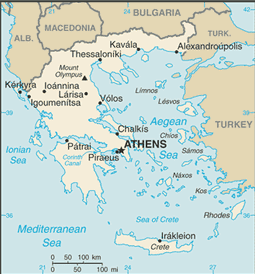Crete
 From Citizendium - Reading time: 2 min
From Citizendium - Reading time: 2 min
Crete (Modern Greek: Κρήτη, Kriti; Ancient Greek: Κρήτη, Krḗtē) is a large island in the Mediterranean Sea south of Greece, currently part of Greece. The Island measures 8 336 km2 and has 623 666 inhabitants (2005). Its capital city is Irakleio and its second largest city is Canea. Crete forms an administrative region (periphery) of Greece and comprises the four prefectures (nomi) of Canea, Rethymno, Irakleio and Lasithi. It is centered at 35 degrees 15 minutes of North latitude and 24 degrees 45 minutes East longitude.

Economy[edit]
Crete has the lowest unemployment in Greece. The tourist sector forms the largest part, but there is substantial agricultural production and processing.
Current military[edit]
There is a large Royal Air Force base at Heraklion and a US-UK signals intelligence facility.
Second World War[edit]
In Operation Mercury, Crete was conquered by German air assault forces, but at extremely heavy cost that prevented Germany from using large airborne forces in the rest of the war.
Ancient society[edit]

It was the site of the Minoan civilization.
In stories from Greek mythology, King Minos had a Minotaur inside a giant labyrinth, but it was killed by the Athenian hero Theseus who used string to find his way out of the maze.
Ancient languages and scripts[edit]
Not much is known about the language of early Minoan civilization, but this language was not Greek. The Greek language (through the archaic variety of Mycenaean Greek) arrived in Crete progressively, approximately from 1450 BC on, during the late period of the Minoan civilization, along with the settlement of Mycenaean rulers.[1][2] Three scripts were used in the Minoan civilization:
- The Cretan hieroglyphs, especially documented thanks to the Phaistos Disc, remain undeciphered. They could have been used to write the early language of Minoans.
- The Linear A syllabary remains undeciphered. It could have been used to write the early language of Minoans.
- The Linear B syllabary is deciphered: it was used to write Mycenaean Greek during the late period of the Minoan civilization. It was totally different from the classical, Greek alphabet, which appeared much later.
Footnotes[edit]
- ↑ As stated in The permanent exhibition of the Irakleio Archaeological Museum.
- ↑ AMOURETTI Marie-Claire & RUZÉ Françoise (1978, reed. 1988) Le Monde grec antique, Paris: Hachette, p. 24, 32, 34-35
 KSF
KSF